Abarth 124 Spider 2020 Owner handbook (in English)
Manufacturer: ABARTH, Model Year: 2020, Model line: 124 Spider, Model: Abarth 124 Spider 2020Pages: 224, PDF Size: 3.9 MB
Page 91 of 224
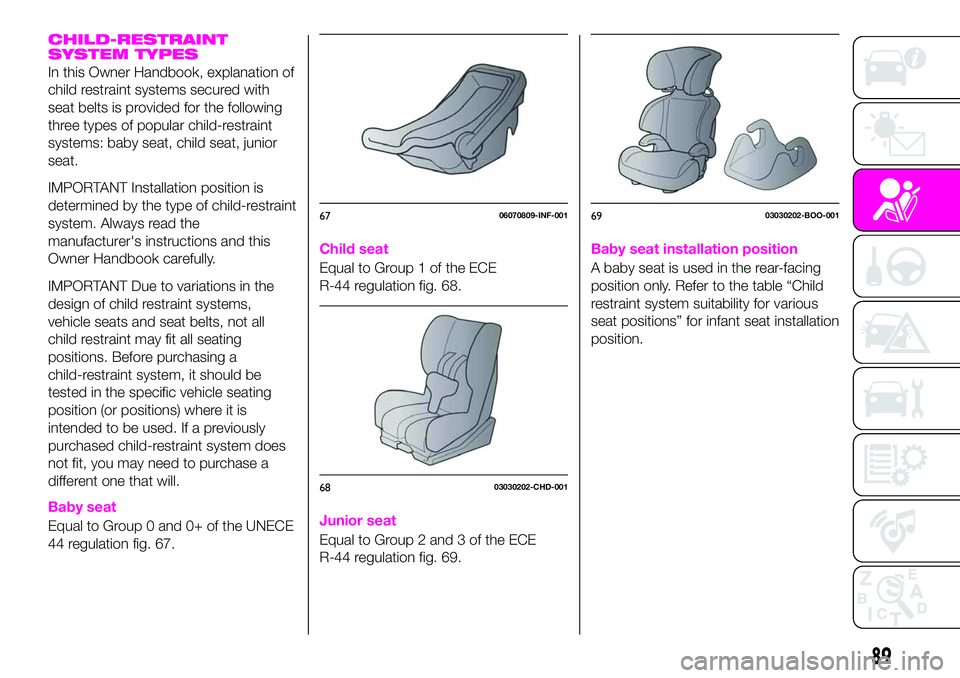
CHILD-RESTRAINT
SYSTEM TYPES
In this Owner Handbook, explanation of
child restraint systems secured with
seat belts is provided for the following
three types of popular child-restraint
systems: baby seat, child seat, junior
seat.
IMPORTANT Installation position is
determined by the type of child-restraint
system. Always read the
manufacturer's instructions and this
Owner Handbook carefully.
IMPORTANT Due to variations in the
design of child restraint systems,
vehicle seats and seat belts, not all
child restraint may fit all seating
positions. Before purchasing a
child-restraint system, it should be
tested in the specific vehicle seating
position (or positions) where it is
intended to be used. If a previously
purchased child-restraint system does
not fit, you may need to purchase a
different one that will.
Baby seat
Equal to Group 0 and 0+ of the UNECE
44 regulation fig. 67.
Child seat
Equal to Group 1 of the ECE
R-44 regulation fig. 68.
Junior seat
Equal to Group 2 and 3 of the ECE
R-44 regulation fig. 69.
Baby seat installation position
A baby seat is used in the rear-facing
position only. Refer to the table “Child
restraint system suitability for various
seat positions” for infant seat installation
position.
6706070809-INF-001
6803030202-CHD-001
6903030202-BOO-001
89
Page 92 of 224
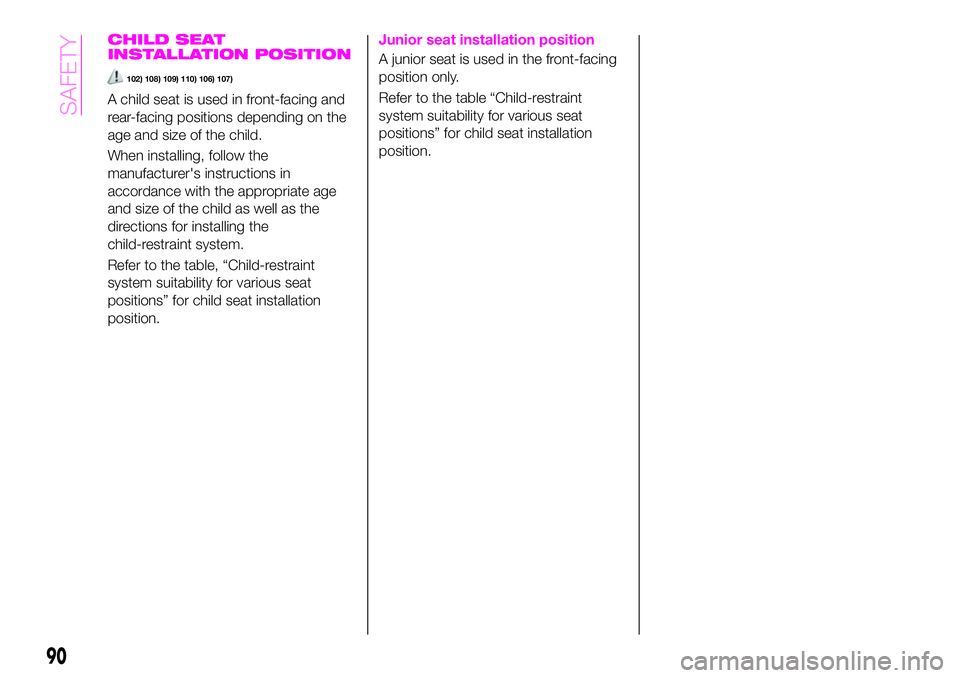
CHILD SEAT
INSTALLATION POSITION
102) 108) 109) 110) 106) 107)
A child seat is used in front-facing and
rear-facing positions depending on the
age and size of the child.
When installing, follow the
manufacturer's instructions in
accordance with the appropriate age
and size of the child as well as the
directions for installing the
child-restraint system.
Refer to the table, “Child-restraint
system suitability for various seat
positions” for child seat installation
position.
Junior seat installation position
A junior seat is used in the front-facing
position only.
Refer to the table “Child-restraint
system suitability for various seat
positions” for child seat installation
position.
90
SAFETY
Page 93 of 224
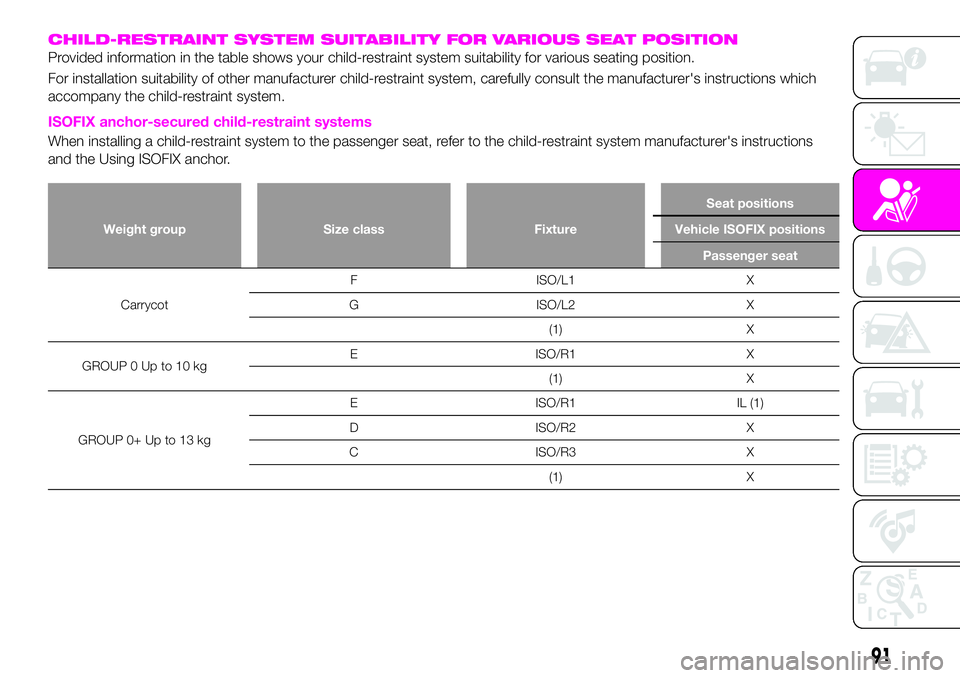
CHILD-RESTRAINT SYSTEM SUITABILITY FOR VARIOUS SEAT POSITION
Provided information in the table shows your child-restraint system suitability for various seating position.
For installation suitability of other manufacturer child-restraint system, carefully consult the manufacturer's instructions which
accompany the child-restraint system.
ISOFIX anchor-secured child-restraint systems
When installing a child-restraint system to the passenger seat, refer to the child-restraint system manufacturer's instructions
and the Using ISOFIX anchor.
Weight group Size class FixtureSeat positions
Vehicle ISOFIX positions
Passenger seat
CarrycotF ISO/L1 X
G ISO/L2 X
(1) X
GROUP 0 Up to 10 kgE ISO/R1 X
(1) X
GROUP 0+ Up to 13 kgE ISO/R1 IL (1)
D ISO/R2 X
C ISO/R3 X
(1) X
91
Page 94 of 224

Weight group Size class FixtureSeat positions
Vehicle ISOFIX positions
Passenger seat
GROUP19kg–18kgD ISO/R2 X
C ISO/R3 X
B ISO/F2 IUF
B1 ISO/F2X IUF
A ISO/F3 X
(1) IL (2)
GROUP 2 15 kg – 25 kg (1) IL (3)
GROUP 3 22 kg – 36 kg (1) IL (3)
(1) For the CRS which do not carry the ISO/XX size class identification (A to G), for the applicable weight group, the car
manufacturer shall indicate the vehicle specific ISOFIX child-restraint system(s) recommended for each position.
IUF = Suitable for ISOFIX forward child-restraints systems of universal category approved for use in this mass group.
IL = Suitable for particular ISOFIX child-restraint systems (CRS) given in the attached list.
These ISOFIX CRS are those of the “specific vehicle”, “restricted” or “semi-universal” categories.
(1) A CabrioFix child-restraint attached to an EasyFix Base, both sold by
MAXI-COSI®
can be installed.
(2) Pearl child-restraint attached to an FamilyFix Base, both sold by
MAXI-COSI®
can be installed.
(3)
BRITAX RÖMER®
KIDFIX can be installed (KIDFIX is no longer in production).
X = ISOFIX position not suitable for ISOFIX child-restraint systems in this mass group and/or this size class.
92
SAFETY
Page 95 of 224

i-Size child-restraint systems
An i-Size child-restraint system can be installed to the specified seat as follows:
Passenger seat
i-Size child-restraint systems X
X = Seating position not suitable for i-Size “universal” child-restraint systems.
IMPORTANT An i-Size child-restraint system refers to a child-restraint system which has acquired i-Size category certification
for the UNECE 129 regulation.
93
Page 96 of 224

Seat belt-secured child-restraint systems
System group Age group Weight groupChild-restraint
system typePassenger seat
Without a
passenger
occupant
classification
system
(Air bag
enabled)(Air bag
disabled)
GROUP 0Up to about
9 months oldUp to 10 kg Baby seat X X U
GROUP 0+Up to about
2 years oldUp to 13 kg Baby seat X X U
GROUP 1About 8 months
to 4 years old9 kg - 18 kg Child seat L UF U
GROUP 2About 3 to
7 years old15 kg - 25 kg Junior seat L UF U
GROUP 3About 6 to
12 years old22 kg - 36 kg Junior seat L UF U
U = Suitable for “universal” category restraints approved for use in this weight group.
UF = Suitable for forward-facing “universal” category restraints approved for use in this weight group.
Regarding child-restraint systems which can be installed, refer to the accessories catalog.
L = For the child-restraint systems categorized in this weight group, consult an expert repairer, we recommend an authorised
Dealership.
X = Seat position not suitable for children in this weight group.
94
SAFETY
Page 97 of 224
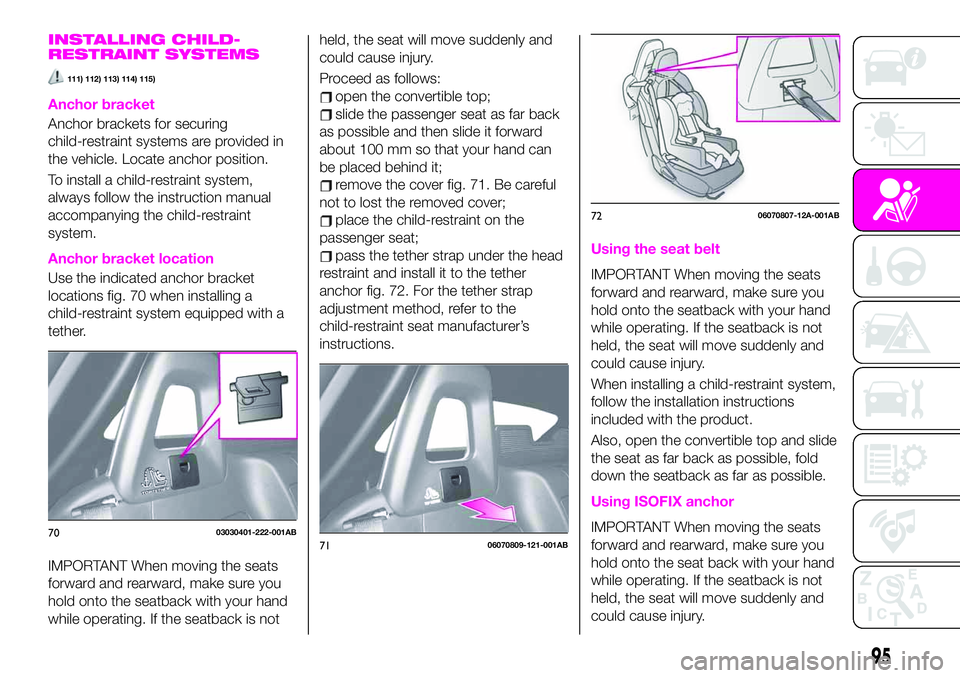
INSTALLING CHILD-
RESTRAINT SYSTEMS
111) 112) 113) 114) 115)
Anchor bracket
Anchor brackets for securing
child-restraint systems are provided in
the vehicle. Locate anchor position.
To install a child-restraint system,
always follow the instruction manual
accompanying the child-restraint
system.
Anchor bracket location
Use the indicated anchor bracket
locations fig. 70 when installing a
child-restraint system equipped with a
tether.
IMPORTANT When moving the seats
forward and rearward, make sure you
hold onto the seatback with your hand
while operating. If the seatback is notheld, the seat will move suddenly and
could cause injury.
Proceed as follows:
open the convertible top;
slide the passenger seat as far back
as possible and then slide it forward
about 100 mm so that your hand can
be placed behind it;
remove the cover fig. 71. Be careful
not to lost the removed cover;
place the child-restraint on the
passenger seat;
pass the tether strap under the head
restraint and install it to the tether
anchor fig. 72. For the tether strap
adjustment method, refer to the
child-restraint seat manufacturer’s
instructions.Using the seat belt
IMPORTANT When moving the seats
forward and rearward, make sure you
hold onto the seatback with your hand
while operating. If the seatback is not
held, the seat will move suddenly and
could cause injury.
When installing a child-restraint system,
follow the installation instructions
included with the product.
Also, open the convertible top and slide
the seat as far back as possible, fold
down the seatback as far as possible.
Using ISOFIX anchor
IMPORTANT When moving the seats
forward and rearward, make sure you
hold onto the seat back with your hand
while operating. If the seatback is not
held, the seat will move suddenly and
could cause injury.7003030401-222-001AB7106070809-121-001AB
7206070807-12A-001AB
95
Page 98 of 224

Proceed as follows:
open the convertible top;
make sure the ignition is switched
off;
slide the passenger seat as far back
as possible. You may need to move the
seat forward slightly and recline the
back of the seat, in order to assist in
the fittment of some child-restraint
systems;
make sure the seatback is securely
latched by pushing it back until it is fully
locked;
expand the area between the seat
bottom and the seatback slightly to
verify the locations of the ISOFIX
anchor.
IMPORTANT The markings above the
ISOFIX anchors indicate the locations of
the ISOFIX anchors for the attachment
of a child-restraint system.
secure the child-restraint system
using the ISOFIX anchor, following the
child-restraint system manufacturer's
instruction;
switch the ignition ON and make
sure the OFF passenger air bag
deactivation indicator light
fig. 74 illuminates after installing a
child-restraint system on the passenger
seat (see “Passenger Air Bag
deactivation indicator lights”
paragraph). If the passenger air bag
OFF deactivation indicator light does
not illuminate, remove the child-restraint
system, switch the ignition to OFF, and
then reinstall the child-restraint system;
if your child-restraint system came
equipped with a tether, that probably
means it is very important to properly
secure the tether for child safety. Please
carefully follow the child-restraint
system manufacturer's instructions
when installing tethers.
WARNING
94)Use the correct size child-restraint
system. For effective protection in vehicle
accidents and sudden stops, a child must
be properly restrained using a seat belt or
child-restraint system depending on age
and size. If not, the child could be seriously
injured or even killed in an accident.
95)Follow the manufacturer's instructions
and always keep the child-restraint system
buckled down. An unsecured
child-restraint system is dangerous. In a
sudden stop or a collision it could move
causing serious injury or death to the child
or other occupants. Make sure any
child-restraint system is properly secured in
place according to the child-restraint
system manufacturer's instructions. When
not in use, remove it from the vehicle or
fasten it with a seat belt, or latch it down to
BOTH ISOFIX anchors, and attach the
corresponding tether anchor.
7306070808-12A-001AB
7406070432-121-001AB
96
SAFETY
Page 99 of 224
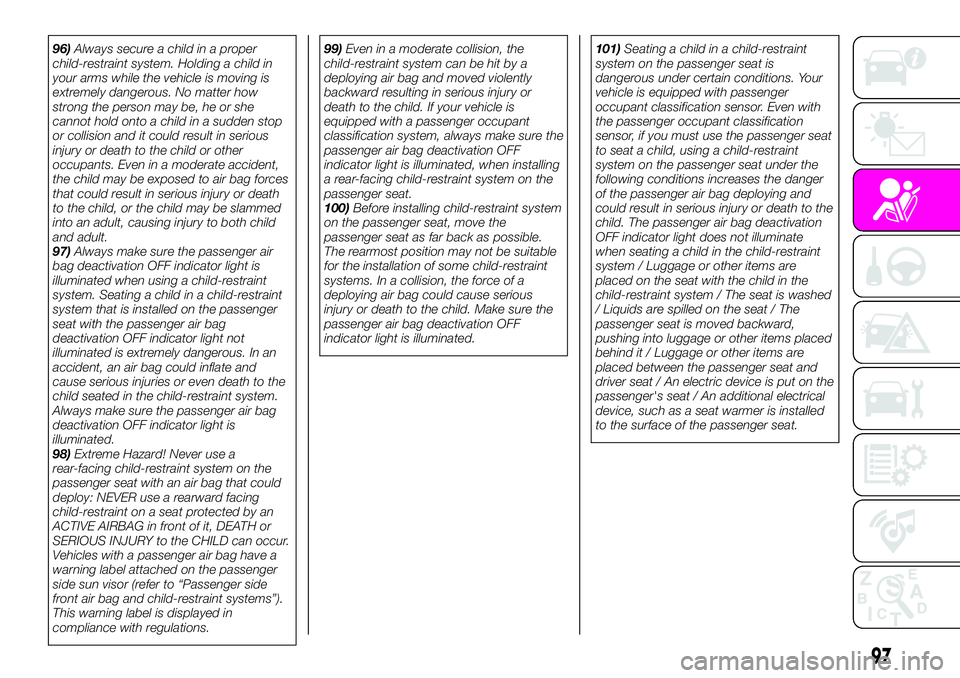
96)Always secure a child in a proper
child-restraint system. Holding a child in
your arms while the vehicle is moving is
extremely dangerous. No matter how
strong the person may be, he or she
cannot hold onto a child in a sudden stop
or collision and it could result in serious
injury or death to the child or other
occupants. Even in a moderate accident,
the child may be exposed to air bag forces
that could result in serious injury or death
to the child, or the child may be slammed
into an adult, causing injury to both child
and adult.
97)Always make sure the passenger air
bag deactivation OFF indicator light is
illuminated when using a child-restraint
system. Seating a child in a child-restraint
system that is installed on the passenger
seat with the passenger air bag
deactivation OFF indicator light not
illuminated is extremely dangerous. In an
accident, an air bag could inflate and
cause serious injuries or even death to the
child seated in the child-restraint system.
Always make sure the passenger air bag
deactivation OFF indicator light is
illuminated.
98)Extreme Hazard! Never use a
rear-facing child-restraint system on the
passenger seat with an air bag that could
deploy: NEVER use a rearward facing
child-restraint on a seat protected by an
ACTIVE AIRBAG in front of it, DEATH or
SERIOUS INJURY to the CHILD can occur.
Vehicles with a passenger air bag have a
warning label attached on the passenger
side sun visor (refer to “Passenger side
front air bag and child-restraint systems”).
This warning label is displayed in
compliance with regulations.99)Even in a moderate collision, the
child-restraint system can be hit by a
deploying air bag and moved violently
backward resulting in serious injury or
death to the child. If your vehicle is
equipped with a passenger occupant
classification system, always make sure the
passenger air bag deactivation OFF
indicator light is illuminated, when installing
a rear-facing child-restraint system on the
passenger seat.
100)Before installing child-restraint system
on the passenger seat, move the
passenger seat as far back as possible.
The rearmost position may not be suitable
for the installation of some child-restraint
systems. In a collision, the force of a
deploying air bag could cause serious
injury or death to the child. Make sure the
passenger air bag deactivation OFF
indicator light is illuminated.101)Seating a child in a child-restraint
system on the passenger seat is
dangerous under certain conditions. Your
vehicle is equipped with passenger
occupant classification sensor. Even with
the passenger occupant classification
sensor, if you must use the passenger seat
to seat a child, using a child-restraint
system on the passenger seat under the
following conditions increases the danger
of the passenger air bag deploying and
could result in serious injury or death to the
child. The passenger air bag deactivation
OFF indicator light does not illuminate
when seating a child in the child-restraint
system / Luggage or other items are
placed on the seat with the child in the
child-restraint system / The seat is washed
/ Liquids are spilled on the seat / The
passenger seat is moved backward,
pushing into luggage or other items placed
behind it / Luggage or other items are
placed between the passenger seat and
driver seat / An electric device is put on the
passenger's seat / An additional electrical
device, such as a seat warmer is installed
to the surface of the passenger seat.
97
Page 100 of 224

102)Do not allow a child or anyone to lean
over or against the side window of a
vehicle with side air bags. It is dangerous
to allow anyone to lean over or against the
side window, the area of the passenger
seat from which the side air bags deploy,
even if a child-restraint system is used. The
impact of inflation from a side air bag could
cause serious injury or death to an out of
position child. Furthermore, leaning over or
against the door could block the side air
bags and eliminate the advantages of
supplementary protection. Because the
side air bag deploys from the outer
shoulder of the seat, do not allow the child
to lean over or against the side window,
even if the child is seated in a
child-restraint system.
103)Never use one seat belt on more than
one person at a time. Using one seat belt
for more than one person at a time is
dangerous. A seat belt used in this way
cannot spread the impact forces properly
and the two passengers could be crushed
together and seriously injured or even
killed. Never use one belt for more than
one person at a time and always operate
the vehicle with each occupant properly
restrained.
104)Use the tether and tether anchor only
for a child-restraint system. Child-restraint
system anchorages are designed to
withstand only those loads imposed by
correctly installed child-restraint systems.
Under no circumstances are they to be
used for adult seat belts, harnesses, or for
attaching other items or equipment to the
vehicle.105)Always install a rear-facing child seat
in the correct seat position. Installing a
rear-facing child seat without first
consulting the table “Child-restraint system
suitability for various seat positions” is
dangerous. A rear-facing child seat
installed on the wrong seat position cannot
be properly secured. In a collision, the child
could hit something or someone in the
vehicle and be seriously injured or even
killed.
106)Always install a junior seat in the
correct seat position. Installing a junior seat
without first consulting the table
“Child-restraint system suitability for
various seat positions” is dangerous. A
junior seat installed on the wrong seat
position cannot be properly secured. In a
collision, the child could hit something or
someone in the vehicle and be seriously
injured or even killed.
107)Always install a baby seat in the
correct seat position. Installing a baby seat
without first consulting the table
“Child-restraint system suitability for
various seat positions” is dangerous. A
baby seat installed on the wrong seat
position cannot be properly secured. In a
collision, the child could hit something or
someone in the vehicle and be seriously
injured or even killed.108)Never use a rear-facing child-restraint
system on the passenger seat protected
by an air bag. Extreme Hazard! Do not use
a rearward facing child-restraint on a seat
protected by an airbag in front of it! The
child-restraint system can be hit by the
deploying air bag and knocked out of
position. A child in the child-restraint
system could be seriously injured or killed.
If your vehicle is equipped with a
passenger occupant classification system,
always make sure the passenger air bag
deactivation OFF indicator light is
illuminated, if installing a rear-facing
child-restraint system on the passenger
seat is unavoidable.
109)Never install a front-facing child seat
in the wrong seat position: Installing a
front-facing child seat without first
consulting the table “Child-restraint system
suitability for various seat positions” is
dangerous. A front-facing child seat
installed in the wrong seat position cannot
be properly secured. In a collision, the child
could hit something or someone in the
vehicle and be seriously injured or even
killed. Make sure the passenger air bag
deactivation OFF indicator light is
illuminated.
110)Before installing child-restraint system
on the passenger seat, move the
passenger seat as far back as possible: In
a collision, the force of a deploying air bag
could cause serious injury or death to the
child. Make sure the passenger air bag
deactivation OFF indicator light is
illuminated.
98
SAFETY